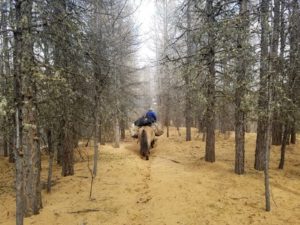by Qingqing Yang, of Colby College
Mongolia Study Abroad – Fall 2019 semester
We camped for 9 days in front of Battogtokh’s (a park ranger) house on the steppe, an expansive grassland surrounded by mountains. On the interspersed lakes here, Bob (nickname for Chris, one of our instructors) and I collected all of our waterbird data. The birds here included horned larks and saker falcons. We found one of these falcons, dead and mostly eaten, underneath a power line. Battogtokh told us that these power lines had electrocuted several swans, an eagle, and other falcons in the last year as well. People are trying to bird-proof the power lines, Bob said. Magpies bounce about, and they would sometimes stand on the sides of the outhouse while I’m in it. Many of them gathered around when Battogtokh and our furagon drivers cut open goats and sheep.
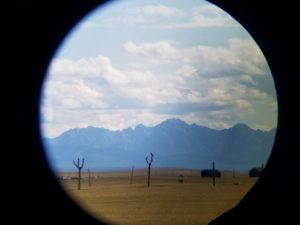
Bob and I counted the waterbirds of many lakes here. The wetlands were cleanly distinct from the rest of the steppe, and they didn’t have much special riparian vegetation. Some of these lakes were small and existed only seasonally, whereas Tsagaan Nuur lay huge and impactful next to Tsagaan Nuur soum center. We saw 13,000 birds in total, mostly comprised of great cormorants, common goldeneye, whooper swans, and tufted ducks. I liked looking for shorebirds, and I was glad to have time to search for these obscure little guys. Phalaropes were among my favorites, as they float and quickly stitch at the water’s surface with sewing needle bills while spinning to create vortices. Also memorable were rotund red knots and a regal Northern lapwing.
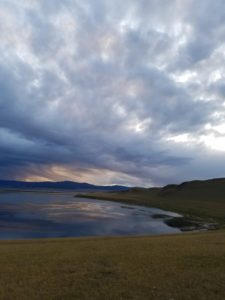
The more charismatic waterbirds we saw include black storks and whooper swans. The swans and their nearly full-sized babies were plentiful in many lakes (our counts reached 300 for a medium sized wetland). They are symbols of monogamy and faithfulness in love for Mongolians, and many people incorporate swan-themed decorations into their homes. We saw two bar-headed geese with neck collars from an avian influenza study, too.

Right before we left the steppe, many of us bought some of Battogtokh’s small wooden animal sculptures. He has a box of many carved argali, pika, bears, and flying squirrels. I bought a shorebird which looks mischievous and a little smug (reminding me of my pet birds at home). When we left, our group split up so that most people could drive back to base camp and do a few daurian pika plots on the way, while Battogtokh, Bob, and I went up to Tsagaan Nuur to count that huge, important lake.
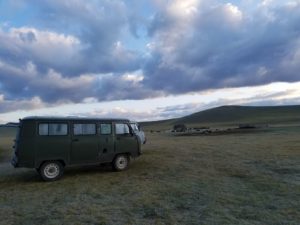
We had been remarking for days about this exciting furagon which Bob, Battogtokh, and I took; I had grown fond of its starter which didn’t work, window which was tied to the car by paracord, front-facing seat which could tilt 45 degrees in two directions, back-facing seat which had broken its welding and frequently bounced up and down (until our driver stuck a log under it), back door which had to be slammed closed, and gear box which got stuck regularly. This was the furagon which had necessitated our midnight extrication before, and, now, with no second vehicle to tow it, we approached a stream crossing apprehensively. Our furagon got stuck. Furthermore, its tailpipe had gotten bent in the streambed. Battogtokh rode off with a stranger to look for help.
Bob and I took the opportunity to walk up to and survey Tsagan Nuur while small, dense scraps of snow drifted down like paper stars. Eventually, a stranger with a furagon came to the rescue, and we scanned Tsagaan Nuur from a different angle while our driver went to fix his car. He came back hours later in our rescuer’s furagon, motioning to us that his own vehicle was destroyed. On the way back to base camp, this replacement furagon broke down twice as well. While our drivers shoved metal sockets into toe juice bottles to fix the car, Battogtokh laughed with us about our comical misfortune (toe juice is what we call a brand of fruit juice which looks like it says “Toe” on the bottle, but it actually says goe, meaning beautiful or delicious). We made it back to base camp at 7:30, only 2.5 hours late. (This wasn’t the only time Bob and I ended up in strange situations while going on the exciting furagon to do bird surveys; the other time involved looking for furagon tracks and eating sheep organs.)
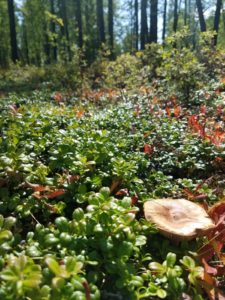
Many Mongolians believe that humans provide for the mountains, and the mountains provide for the humans in return. Walking through the montane forests lined with deep moss, fragrant labrador tea, and pine and larch trees, our group easily collected several liters of cranberries and blueberries. We’ve made blueberry crumble while backpacking by cooking our berries over the fire and eating them with biscuits. Sometimes we eat pine nuts from the trees. In marshy meadows, Nyam-ochir (another ranger with whom we work) showed us to eat the seeds and roots of borgon (a small plant in the Bistorta genus). During our talus pika and vansemberuu research, we’d find gooseberry bushes growing in patches on the rocks. Fireweed is also edible, and Nyam-ochir dries it for his tea. Many more plants have places in Mongolian traditional medicine. It’s easier to imagine sustaining myself off the land now.
Back at base camp, we found a menace of a hainag (cow-yak hybrid) who would bluff charge at us and try to lick our pee. We named him Ron. His herders have migrated away now, but I miss seeing Badmaa (an instructor) chase after him, screaming and flinging water jugs. We took a short backpacking trip to Har Us to collect game cameras, during which we got our first real snowstorm. When we got back, we made apple huushuur (fried dough with a filling), had a movie night, and watched the park staff add felt to our ger (a traditional Mongolian home which we use as a classroom). The fire inside is warm and pervasive now, and we have twenty days left in the Darhad. Mongolians say to never point the soles of your feet at the hearth because it is the center of the household, resting between two poles representing the husband and wife. Our ger certainly is central. We joke about Bob being our adoptive mom, Rebecca (an instructor) being our aunt, and Badmaa being our big sister. When I’m the last one to leave the ger to sleep, I watch the fire hum and think of my future nostalgia for this place and our funny, ephemeral family.
